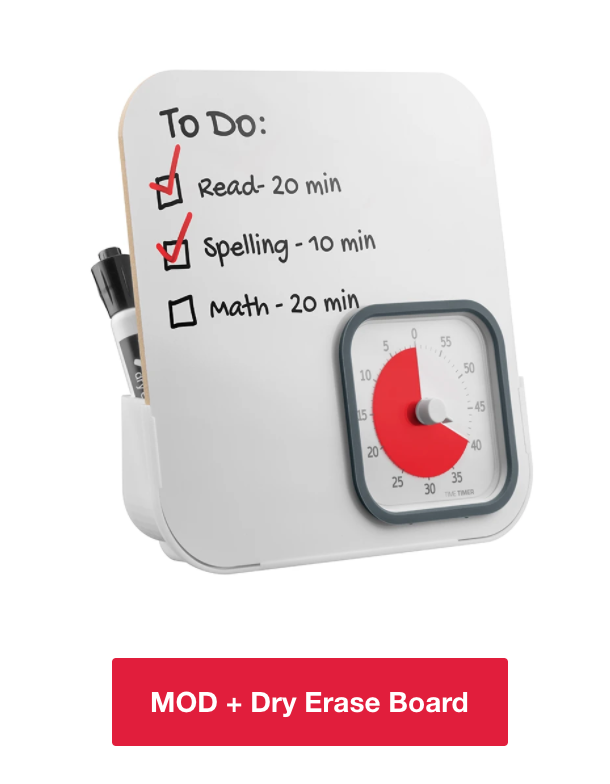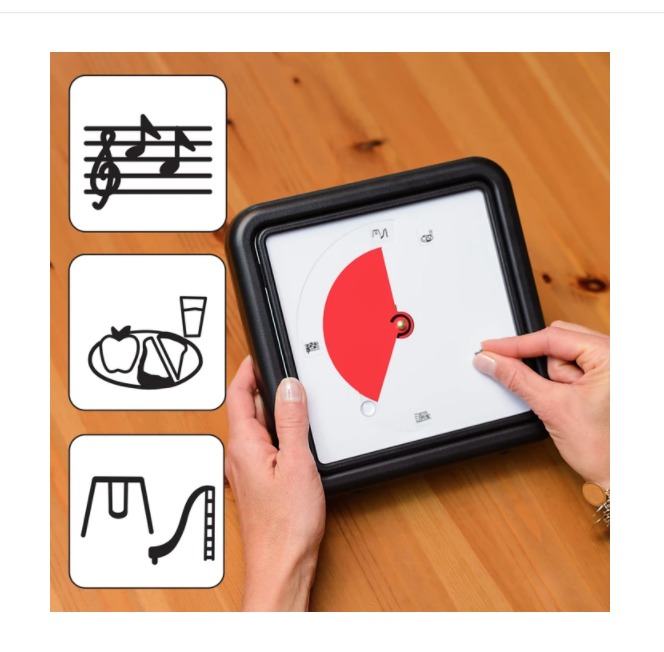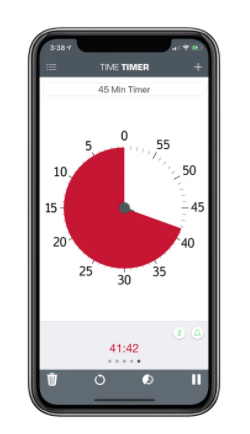
I spent some time today chatting with a lovely woman who is the parent of a high school student with dyslexia. She is bound and determined to help as many children as she can to improve their reading outcomes moving forward. She tutors, but wants to be even better at it and teach others to become tutors. Orchids to her!! I asked her if she was familiar with a Time-Timer—and she wasn’t. I bet you after she reads this blog post, she will run right to her computer or phone and get one (or maybe more).
If you look at my office Bitmoji to the left and/or on my website Blog Page, you will see that I prominently display a Time-Timer on the wall to the right of a picture of Elsa, from Frozen.
Learning about this nifty tool will help you whether you are a parent, teacher, tutor, camp counselor, or any other type of counselor, and finally, if you yourself have some difficulty managing time.
WHAT’S A TIME-TIMER?
As one can see from the picture, a Time-Timer is nothing more than a disc that looks like a clock-face, but is very different. Rather than simply telling the onlooker the current time (for example, 12:00), it tells the onlooker how much time has elapsed and/or how much time ‘is left’ at the task at hand.
The ‘red-disc’ literally shows the onlooker time as it passes. As the Time-Timer website states, “there’s a world of difference between looking at a clock and being able to say that it’s 3 o’clock and understanding “how long” 5 minutes is.” It is very different from an old-fashioned kitchen timer or a new-fangled cell phone stopwatch as one can see from the picture below:

One can actually ‘measure’, or perhaps the better words are ‘perceive’ or ‘experience’, the passage of time using a Time-Timer without the constant ticking or the loud ring at the end of the allotted time to complete a task. In fact, I have had students watch the Time-Timer who tell me they “can’t see the time moving”—And so, I just tell them that we must just “get back to work”. I’ve then seen them ‘sneak a peek’ after a few minutes only to hear them exclaim, “I didn’t see it moving, but it DOES and now I have only 10 minutes left!” After a few repetitions of this scenario, kids begin to develop a better ‘sense of time’.
Jan Rogers, also known as the Timeinator, came up with the idea about 25 years ago to help her own daughter understand the passage of time when her daughter was only 4 years old. Jan stated that her motivation stemmed from “seeing a need I think has not yet been filled…I don’t always have the answer, but Iove the pursuit of the idea.”
In ‘no time’–yes, the pun was intended, the company, based in Cincinnati, took off.
You can also watch a short video explaining the many uses of a Time-Timer: Visual Timer for Visual Learners here.
OK, so why am I telling you about a Time-Timer?
1 – It’s not very expensive and comes in various sizes and formats. In fact, many versions exist as well as a ‘free’ app, which is deemed a ‘time manager’.
2 – It helps children and students ‘manage’ on-task behavior, transitions, as well as time management without the drama or stress of ‘how much longer?’ or ‘are we there yet?’ So…in pre-school settings, it helps with routines such as ‘clean up time’. In elementary school, a Time-Timer helps with keeping to routines and rotation of various ‘learning stations’ and ‘small group instruction’. As children get older, a Time-Timer may help during test taking, particularly high stakes standardized tests such as the ACTs. A Time-Timer may also help keep student presentations on track.
3 – It helps children (and maybe adults?) sustain attention. Did you know that a Microsoft Corporation study indicated that individuals can sustain attention for about 8 seconds and that this is less than in previous years, particularly when the information is read on the internet? That’s because most of us have too much information we need to attend to. So we spend very short bursts of attention on each item and then quickly move on. As a result, attention to any one task on the internet decreases to less than 3 seconds! This has been shown not to be the case with information taken in using printed text. That said, I hope you read this entire blog post!
4 – It serves as a ‘productivity tool’ to increase self-regulation and self-awareness of time passing. In an office (remember those?) a Time-Timer has been shown to keep meetings ‘on track’ and allows them to proceed with a sense of ‘urgency’ so that less time is wasted.
5 – In the home setting, a Time-Timer is often useful for setting the stage for appropriate homework completion and study time for tests (or maybe for adults too, who are trying to work from home?). Some of us may need ‘a break’ after working for 15 minutes, while others can sustain attention for far longer.
6 – During the past 18 months when many children were engaged in either homeschooling or remote learning while their parents worked from home, Time-Timers proved useful in terms of allowing parents to have ‘Do Not Disturb’ time while at the same time allowing children uninterrupted ‘work time’.

7 – Finally, a newer version of the Time-Timer is used to help children perceive ‘how long it takes to wash their hands’ and/or ‘use the toilet’ while potty training. What a concept. I remember very L..O…N…G days when I was attempting to potty train my own kiddos.
HOW DO CHILDREN DEVELOP A PERCEPTION OF OR SENSE OF TIME?
When I was a child, I used to literally think that ‘time stood still’—now, there is NEVER ENOUGH time! How can this be???
According to Miller, Church, and Poole, children learn about ‘time’ right from birth. Very early on, the world is quite chaotic for an infant and the schedules and routines parents set helps to create ‘order from chaos’ (one of my favorite expressions!). Predictability is key to helping a new human feel comfortable and to know what to expect throughout the day and night.
As children get a bit older, the routines and discussions about various activities such as play time, meal time, nap time, story time, bath time, and bedtime pave the way for toddlers and preschoolers to gain a better sense of time. So…when you say, “I’ll be home by dinnertime”, that means something to a younger child. In time, young children measure time in terms of ‘events’ such as birthdays, beginning/end of school, and are introduced to calendars to measure the days passing, etc. They learn the meanings of ‘before’ and ‘after’, as well as ‘early’ and ‘late’, and incorporate these concepts into their increasingly more structured routines. Preschool age children understand that there are tools to measure time such as watches, clocks, and maybe even a Time-Timer! Although most preschoolers cannot read time measurement tools, they sure can understand the ‘red disc’ on a Time-Timer (watch the video I included in this blog post).
By the time children are school age, they learn about the concepts of ‘today’, ‘tomorrow’, ‘yesterday’. Ellen Booth Church points out that, “perhaps the most confusing is the concept of past, present, and future…it is even more abstract then the concepts of today, tomorrow, and yesterday. ” Let me take this one step further. When children learn to speak (and then to read/write), they need to become aware of suffix endings that ‘mark’ the past, present, and future, as well as continuing over a period of time.. For example, when we say or read ‘the baby naps’, it means ‘present’. If we say or read ‘the baby napped’, it means ‘past’. If we say or read ‘the baby will nap’, it means ‘future. And, if we say or read ‘the baby is napping’ or ‘the baby was napping’ or ‘the baby will be napping’, it means that the nap is (present), was (present), or will be (future) either occurring for a continued period of time. Thus, understanding the suffixes -s, -ed, and -ing becomes very important in terms of a child’s language and reading comprehension.
Remember this: there is a continuum of language development. This means that not every school age child will use these terms without error. Our job as parents is to model the correct language and then have our children repeat our model, as well as provide repeated exposures to these words. Children learn the days of the week, months of the year, and the seasons at this time, again along a continuum. They also chart the weather to help children understand time spans. ‘Practice makes permanent.’ This is a phrase I learned so many decades ago–I cannot recall from whom I heard it first, but I think it is true.
CALL TO ACTION: GO GET A TIME-TIMER!! THANK YOU, JAN, FOR SAVING US FROM OURSELVES!
I suspect we can all benefit from paying attention to the use of our time. After all, I believe it is our most precious resource. Don’t waste one more minute negotiating with our children or even ourselves about using time wisely.
NEXT TIME: More ‘Timely’ Information! Stay tuned!






This is such a simple concept/tool that can be so helpful for both children as well as adults. We often forget about the simple solutions. Thank you for sharing it.
This is a great idea. I have never heard of this tool before.